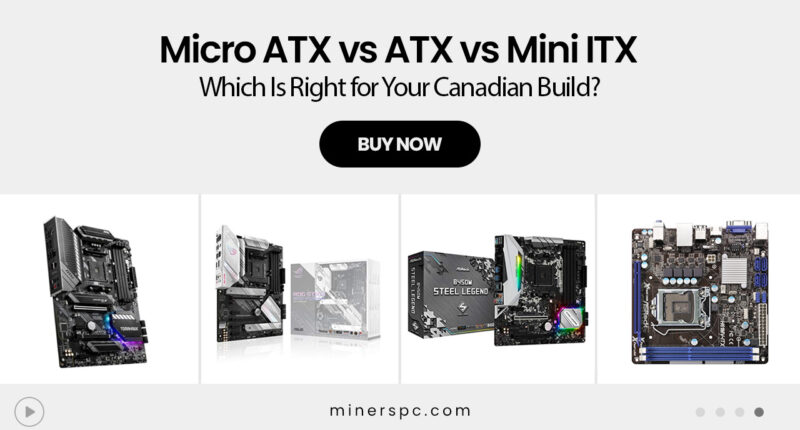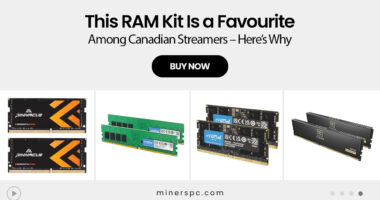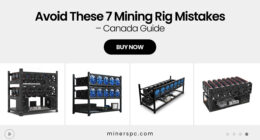Micro ATX vs ATX vs Mini ITX – Which Is Right for Your Canadian Build?
Building a custom PC in Canada means balancing performance, price, and practicality—especially when it comes to your motherboard. Whether you’re assembling a compact powerhouse in Toronto or a full-sized gaming rig in Vancouver, choosing the right motherboard form factor—ATX, Micro ATX (mATX), or Mini ITX—is foundational to how your system performs and fits your lifestyle.
So, how do you decide which one is right for you? Let’s break it down with real-world insights, expert advice, and a look at some top-performing boards that Canadians are loving right now.
What’s the Real Difference Between ATX, Micro ATX, and Mini ITX?
Form factor refers to the physical size and layout of a motherboard, which determines compatibility with cases, power supplies, expansion cards, and cooling options. Here’s how they stack up:
- ATX (Advanced Technology eXtended) – The full-size standard. Ideal for gamers, content creators, and enthusiasts who want maximum performance and expandability.
- Micro ATX (mATX) – A more compact version with fewer expansion slots but nearly all the essentials. Great for budget builds or mid-sized cases.
- Mini ITX – Ultra-compact. Designed for small form factor (SFF) builds, ideal for space-saving desktops or portable gaming setups.
Each has its strengths. The right one for you depends on your goals, space, and future plans.
ATX: Power and Expandability for Demanding Builds
If you’re building a rig that needs room to grow—or already know you’ll be running a high-end GPU, multiple storage drives, and advanced cooling—ATX is your go-to.
Take the MSI MAG B550 Tomahawk Gaming Motherboard, for example. With support for PCIe 4.0, multiple M.2 slots, and a robust VRM setup, it’s tailor-made for Ryzen-powered gaming and productivity machines. Another standout is the ASUS ROG Strix B550-A Gaming, which adds 2.5Gb LAN, RGB headers, and Aura Sync—all housed in a sleek, full-size ATX layout.
These motherboards shine in mid- to full-tower cases and offer headroom for GPU upgrades, more RAM, and advanced cooling setups. If you’re a streamer, video editor, or high-end gamer, ATX ensures you’re not limited by space or connectivity.
Micro ATX: Balanced, Budget-Friendly, and Surprisingly Capable
Not everyone needs the bells and whistles of ATX. Micro ATX boards often offer the same chipset performance but in a smaller, more budget-conscious package.
For AMD builds, the ASRock B450M Steel Legend and MSI B550M PRO-VDH WiFi deliver incredible value. You still get solid features like M.2 slots, good VRMs, and WiFi connectivity—perfect for mid-range gaming or a professional workstation.
From personal experience, I built a compact mATX system for a client in Montreal who needed a work-from-home setup that didn’t take over the room. Using the B550M PRO-VDH and a Ryzen 5600G, we achieved a highly responsive, efficient machine—without breaking the bank or the desk space.
Mini ITX: Small Size, No Compromise
Don’t let the size fool you—Mini ITX boards can be absolute beasts. Designed for compact builds, they’re ideal for minimalists, travelers, or anyone building a living room gaming PC or streaming setup.
The ASUS ROG STRIX B860-I GAMING WIFI and GIGABYTE B860I AORUS PRO ICE prove that big performance can come in small packages. These Mini ITX boards support PCIe 5.0, Thunderbolt 4, WiFi 7, and DDR5—packing elite tech into a board smaller than a notepad.
If you’re planning a sleek, console-sized PC to sit beside your TV in Calgary or you want to travel with your rig, Mini ITX gives you portability without sacrificing speed or stability. Another solid pick is the ASRock Intel Core Ultra B860I, ideal for next-gen Intel builds that demand ultra-fast memory and compact efficiency.
Practical Tips for Canadian Builders
- Climate Considerations: In colder provinces like Alberta, airflow might not be as big a concern, but in warmer areas or during the summer, tight Mini ITX builds may run hotter. Be mindful of airflow and case compatibility.
- Desk Space & Aesthetics: Smaller cases are easier to place and more minimalist in appearance. If your workspace is shared or limited, Micro ATX or Mini ITX could be the smarter choice.
- Upgrade Potential: ATX gives you more PCIe slots for future upgrades—great if you plan to add capture cards, sound cards, or more storage down the line.
- Build Difficulty: Mini ITX builds often require precise cable management and premium cooling solutions. If it’s your first build, Micro ATX might be easier to work with.
Expert Insight: What I Recommend
If you’re gaming and want full future-proofing, go ATX with something like the MSI MAG B550 Tomahawk.
If you’re on a budget but don’t want to skimp on performance, Micro ATX boards like the ASRock B450M Steel Legend are unbeatable.
And if you’re building a minimalist powerhouse—especially for travel, streaming, or living-room setups—the Mini ITX options like ASUS ROG STRIX B860-I or ASRock H610M-ITX deliver compact performance with modern connectivity.
Each format serves a purpose—it’s all about matching your build to your lifestyle.
Final Thoughts: Pick the Form That Fits Your Future
Choosing the right motherboard form factor is more than a size decision—it’s about building a PC that fits your goals, space, and vision. Whether you’re crafting a compact creation station in Nova Scotia or a high-end battle station in British Columbia, there’s a board that fits the bill.
Looking for the perfect pick? Explore the top recommendations below while they’re still available – these won’t stay in stock for long.
















![Best Prebuilt PCs in Canada for Work, School & Gaming [2025 Guide]](https://www.minerspc.com/wp-content/uploads/2025/07/best-prebuilt-pcs-in-canada-for-work-school-gaming-2025-guide-260x140.jpg)


